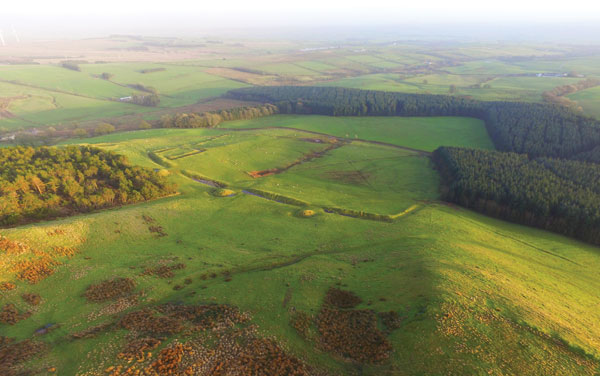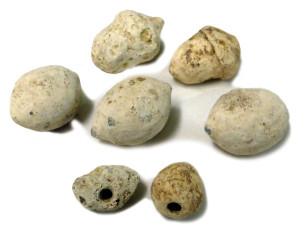A Roman assault on a hillfort in Scotland

The south Roman camp at Burnswark.
The ancient author Josephus once observed of the Roman military that ‘their training manoeuvres are battles without bloodshed, and their battles manoeuvres with bloodshed’. The difficulty in distinguishing between these states is well illustrated by the residue from a Roman artillery barrage at Burnswark. Were they aiming at practice or to suppress defenders before an assault? John Reid reveals the latest discoveries at the site.
The brooding eminence of Burnswark Hill, Dumfriesshire, is an arresting sight. It rises to nearly 1,000 feet from the gentle surrounding countryside and is one of the most prominent landmarks of the Solway basin. Crowning the tabletop summit are the denuded ramparts of a 17-acre hillfort, which is held in a vice-like grip by two Roman camps. Both of these camps feature design oddities. The northern one displays an unusually elongated form, while the south camp is more conventional in shape, but was furnished with three wide gateways facing up the hill. This configuration of Roman camps straddling a hillfort is unique in Britain, and attempts to understand its significance have provoked considerable controversy for over half a century.
Explore the earthworks from the sky – click below to watch drone footage of the site:
Practice camp or siege work?
For nearly two centuries the Roman earthworks were identified as siege camps, but in the 1960s a new theory emerged. This held that the camps were ‘practice’ works and helped to satisfy a growing desire to find tangible evidence for the Roman army’s famous training regime. It is not difficult to see how the practice theory arose. Many archaeologists in the 1950s and 1960s were ex-military men with a grounding in the Classics and close associations with the training activities of the British Army. Indeed, the first to propagate the training camp idea was Kenneth Steer, a real-life ‘Monuments Man’ with an army intelligence background. Unlike many archaeological musings influenced by the zeitgeist, though, the practice interpretation of Burnswark has proved tenacious, entering the popular and academic literature as fact.

A partially excavated type I bullet.
Roman missiles
Burnswark is witness to a greater number and variety of Roman projectiles on a native site than anywhere else in Britain. Indeed, one has to travel to the Near East to find another site as rich in in-situ ballistic material. Prior to the current project, 130 lead sling-bullets, nine trilobate iron arrowheads, and 11 carved sandstone ballista-balls had been identified. Of these, the lead sling-bullets were recognised to belong to two main types. Stephen Greep, who published the first review of Roman sling-bullets from the UK, characterised them as type I, essentially a lemon shape, and type II, which resembles an acorn. What was not fully appreciated at that time was that the rarer acorn-shaped bullets were almost exclusive to a 50-mile radius around Burnswark Hill. Averaging 50g, these beautifully cast bullets were predominantly recovered from the east and central south-facing hillfort gateways, with a handful also found in the south Roman camp.

Three distinct morphologies of lead bullets – type I (lemon), type II (acorn), and type III (small, with a mysterious hole).
A detailed study was undertaken of the missiles from Burnswark held by the National Museum of Scotland and the Dumfries Museum. The range and shape of the carved stone ballista-balls were particularly interesting. These red sandstone missiles, weighing on average 600g, were virtually all grapefruit-shaped and had at least one slightly flattened face. Alan Wilkins, an expert on Roman artillery, confirmed that the flat area would lie in the slider ‘slot’ of the torsion catapult and help stabilise the ball prior to shooting. He also observed that the stone shot were in the lightweight class compared to some of their larger brethren loosed in Judaea. This suggests that they were selected not for their wall-smashing qualities, but their anti-personnel attributes.
It was an assessment of the slingshot, however, that produced the greatest surprise. Some of the type I lemon-shaped bullets were significantly smaller than the others, many weighing less than 20g. We had identified a third, previously unrecognised, slingshot subgroup. Even more interesting was the fact that these small shot contained a single circular hole, approximately 5mm in diameter and about 5mm deep. What could it be for? Was it a hole for fixing to a device, inserting poison, or even a very symmetrical air bubble? Field-testing replica slingshot soon offered another, equally remarkable, explanation for these cavities.
Slinging experiments
We undertook a ballistic assessment of the lead sling-bullets previously found on the site in order to assess the performance of this ammunition. A number of replica bullets were cast in lead and high-density clay, and one of our volunteers, an expert slinger, learned to weave slings from various materials. We found that the larger 50g bullets could be cast at least 200 metres depending on whether the low-trajectory direct (more accurate) or lob style (greater distance) of slinging was used. Other experimenters in the field have noted that a 50g Roman bullet propelled from a sling has only slightly less kinetic energy than a shot from a .44 Magnum!

Don, our slinging expert, at full cast with one of the replica slings.
On our rugby-field firing range a number of results quickly became apparent. Despite painting the bullets Day-Glo orange, finding spent lead missiles was in most cases impossible, as they buried themselves under the grass, confirming that the Romans would not have been able to recover many after the action. When our slinger was pressurised to shoot quickly, he showed a tendency to drop approximately 5-10% of sling bullets while loading. This phenomenon of ‘dropped’ ammunition has been noted by battlefield archaeologists across a number of time periods and theatres of war. It is almost certainly a product of stress, and means that the scatter of bullets in the south camp at Burnswark could reveal where the slingers had been stationed at the start of the action.
Two extraordinary facts concerning the small bullets with holes (now dubbed type IIIs) also emerged. First, they could be successfully slung in small groups of three or four to create a form of grapeshot. This had been independently confirmed by T Richardson in his work on Roman sling-bullets at the Royal Armouries. Even more intriguingly, the mysterious holes proved to confer an aerophonic quality: in flight, these lead shot whistled, or more accurately gave off a mechanical buzzing sound eerily reminiscent of an agitated wasp (click below to hear for yourself). Remarkable as it sounds, the simplest explanation for this design modification is that it represents an early form of psychological warfare. To put it another way, the Roman attackers valued the terror that hearing the incoming bullets would instil in the defenders.
This is an extract from Bullets, ballistas, and Burnswark – read the full story in CA 316. Click here to subscribe.
Listen to the extended buzz of the type III bullets: